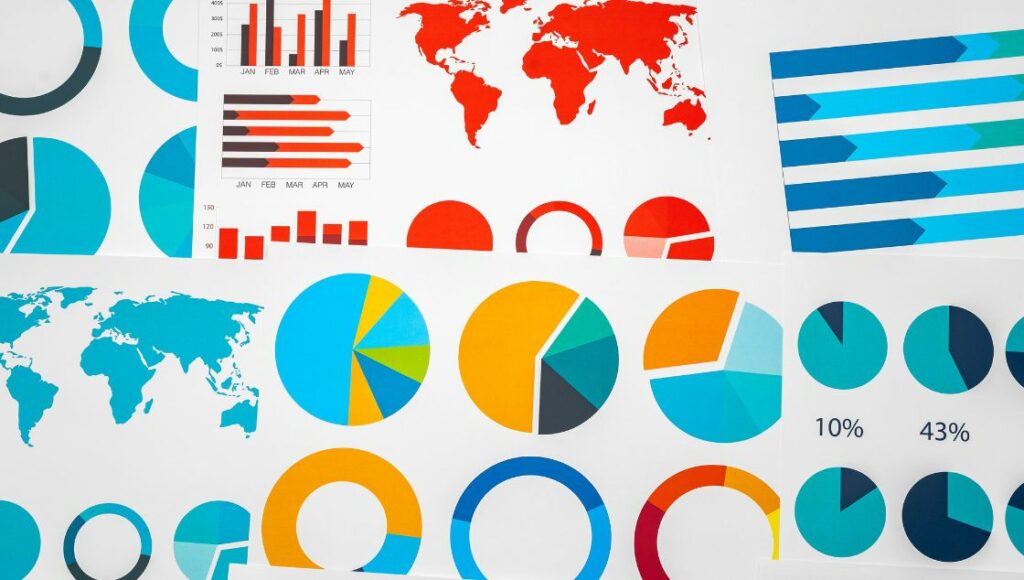How to Apply Bubble Charts in Market Analysis Reports and Presentations
Bubble charts provide a powerful way to visualize complex data intuitively. By plotting categories on the X-axis, performance metrics on the Y-axis, and a third data dimension through relative bubble sizes, bubble charts allow readers to identify patterns and relationships between multidimensional data points quickly.
This ability to compare metrics across groups, spot correlations, and uncover insights makes bubble charts an extremely useful addition to any market analysis report or presentation.
In this article, we’ll explore the best practices for structuring bubble chart components to enable persuasive and actionable market analysis.
Uses and Benefits of Bubble Charts for Market Analysis
Here are some of the top ways bubble charts can be leveraged for market visualization and analysis:
1. Compare product/offering performance across markets: Show y-axis metrics like sales or downloads and use the bubble size to represent usage or engagement rates. Viewers can clearly see high vs low potential areas.
2. Benchmark competitive positioning: Use x-axis for major competitors and y-axis for metrics like market share or customer satisfaction score. The bubble size can show number of customers/subscribers. This allows for competitive analysis.
3. Analyze growth trends: With the x-axis as a timeline, the y-axis as a growth metric, and the bubble size demonstrating transaction volumes/customer numbers, historical trends become visual.
4. Portray correlation between metrics: Plot lead conversion % along y-axis and bubble size as number of inquiries to demonstrate effectiveness of channels in generating quality leads.
5. Geographic/demographic analysis: Categorize the x-axis by regions, customer segments, etc., plot metrics like sales or digital traction through the y-axis and bubble size. Uncover target markets.
6. Social media analytics: Use the x-axis for major platforms, the y-axis for engagement/impressions and bubble size for follower counts. Compare effectiveness for branding.
As evident, bubble charts lend themselves well to analyzing target groups, benchmarking performance, comparing offerings, and unraveling interrelationships between metrics. Marketers can build comprehensive reports and dashboards fueled by bubble chart visualizations.
Steps to Build a Bubble Chart for Market Analysis

Here is an overview of the key steps involved:
1. Identify the key dimensions for analysis: What categories, metrics and measures will provide actionable insights for intended objectives? Align data sets accordingly.
2. Structure the dimensions into appropriate axes: Map categories and groups onto the x-axis; measurable performance indicators onto the y-axis. Metrics that demonstrate relative impact are ideal for bubble size.
3. Prepare the underlying data set: Ensure data fields are appropriately categorized, and metrics are quantified for plotting onto axes and bubble size.
4. Determine suitable scale and proportions: Establish minimum and maximum values along axes such that variation patterns are clearly revealed without excessive empty space.
5. Map data fields onto chart components: Assign data labels clearly onto x and y axes. Compute bubble size to help uncover relationships between metrics.
6. Format chart elements and customize layout: Format chart, axes and label title/text for clarity. Consider monochromatic color schemes for bubbles to avoid distraction.
7. Analyze patterns and interrelationships: Through integrated analysis of all chart components, spot trends across categories, correlate metrics, and identify areas warranting further investigation.
By following these steps and applying appropriate analytical thinking, bubble charts can yield insight to guide marketing strategy. The key lies in structuring the most informative combination of data dimensions.
Interpreting Insights from Bubble Charts in Market Analysis
Bubble charts display data and invite in-depth interpretation to extract meaningful insights. Marketers must develop the skill of reading these charts to identify trends, outliers, and correlations that can influence business decisions. Here’s how to interpret bubble charts effectively:
- Identifying Key Players: In competitive analysis, large bubbles in high-value areas (e.g., high market share and customer satisfaction) highlight dominant competitors, while smaller bubbles suggest areas of opportunity or underperformance.
- Spotting Growth Opportunities: By tracking bubble movement across the x-axis (timeline), marketers can identify growth trends over time and uncover emerging opportunities in markets or customer segments.
- Evaluating Performance Gaps: Comparing bubble sizes across categories (e.g., product performance or customer engagement metrics) helps businesses pinpoint areas for improvement.
By understanding these nuances, marketers can derive strategic insights and make informed decisions based on their bubble chart visualizations.
Optimizing Bubble Charts for Persuasive Presentations
Bubble charts’ interactive and visual nature makes them useful mediums for communicating key insights, telling data stories, and convincing audiences.
Here are some tips to optimize bubble chart presentations:
1. Maintain appropriate complexity: Include only essential data dimensions. Too many bubbles blind the key takeaways.
2. Keep it simple aesthetically: Avoid flashy designs and inconsistent coloring. Use minimalist templates, allowing data patterns to be self-evident.
3. Guide audience focus: Use callouts, annotations and highlights judiciously to emphasize key messages or trends. Let audiences connect the dots.
4. Lead with insights: Preface each chart with the core insight it aims to communicate so audiences know where to focus.
5. Set up visual triggers: Position successive charts to reflect improvement, patterns, relationships, etc.
6. Link to strategy: Follow each chart with an explanation of strategic implications or decisions that can be made based on the unveiled patterns or trends.
7. Limit presenter commentary: Allow time for audiences to absorb information visually with minimal narration. Be responsive to queries.
With strategic data structuring, thoughtful customization and an audience-centred approach, bubble chart presentations can pack a more compelling punch for market analysis reporting.
Conclusion
Bubble charts are an extremely versatile market analysis tool that allows multifaceted representations through efficient visual mapping of diverse data categories, metrics, and measures. Marketers can apply bubble chart techniques across functions, from marketing mix analysis and performance benchmarking to demand forecasting and positioning strategies.
The key is structuring charts to bring forth actionable patterns and insights, answering specific strategic questions. With practice, marketers can master the bubble chart to make market analysis reporting more engaging, communicative and insightful.







